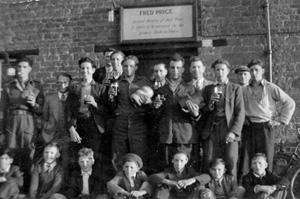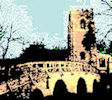Bottle Kicking - History or Legends?
Properly known as Hare Pie Scrambling and Bottle Kicking
 |
| Medbourne's victorious 1948 team |
In the history of Bottle Kicking, Medbourne's involvement is relatively recent, dating back to some time in the first half of the 19th century. The Easter Monday custom dates back hundreds of years and would have involved the menfolk of Hallaton competing against one another. To understand how the customs are played out today click here.
So how did it all start? Nobody really knows; there are stories passed down the ages and there is some physical historical evidence.
Two Ladies, a Bull and a Hare
The story passed down through time involves two Hallaton ladies crossing a field. They were noticed by a bull which gave charge on seeing them. At the last minute a hare appeared, thereby deflecting the bull's charge and saving the ladies from severe injury or even death.
The ladies gave thanks to God. They also made a more tangible gift to the church by donating the rents from a furlong, known as Hare Crop Leys, to the local Rector. With the donation came a condition: the Rector was to provide two hare pies, two dozen penny loaves and a quantity of ale annually to the people of Hallaton. He was also required to conduct a service each Easter Monday.
There is some evidence to support the ownership of the land. John Nicholls' 1797 "History and Antiquities of Leicestershire" refers to both Hare Crop Leys and Hare Pie Bank. The Enclosure Award of 1771 shows the Hallaton Rector being given Parson's Leys in lieu of Hare Crop Leys, and ecclesaistical records show the bequest of land at Hare Crop Leys. (For reference, "leys" is an old word for "pasture".)
The inclusion of the name Hare Pie Bank in Nicholls indicates that the custom was well-established before 1797.
The Hare and the Easter Bunny
The hare is an animal well-known for its cavorting in the Spring. To the pagan peoples the hare was a symbol of good luck and fertility. The beginning of Spring was celebrated by the pagans, and it is likely that the hare was sacrificed as a fertility rite to the goddess Eastre.
When Christianity came it incorporated pagan terms and customs into its own ceremonies. Hence, some believe that today's Easter Bunny is a sanitised reference to the ancient sacrifice of a hare.
The Shrine at Hare Pie Bank
Hallaton's history dates back to the Romans and the church shows evidence of the Normans. Hare Pie Bank is an obvious place for meetings and gatherings. The land between the routes up the Bank is still known as Stowe Close, where the name "Stoe" means a meeting place in old English. Thus it can be conjectured that Hare Pie Bank was the place used by the pagans for their sacrifices.
There is evidence of a chapel that once stood on top of Hare Pie Bank. This is believed to be a shrine to Saint Morrell, a saint better known in France than England. It is likely that a Norman family would have wanted to respect their own saint after their arrival in Hallaton. There was also evidence of a Holy well known both as St. Morrell's Well and Stowe Well. In the 11th and 12th centuries Hallaton was a place of pilgrimage for devotess of St. Morrell.
Looking at all the evidence, it seems that Hare Pie Bank was a place of gatherings and religious significance for at least 800 years.
Conclusions
 |
| Medbourne's 1950 team |
It's impossible to know the exact derivation of today's customs; doubtless they have evolved gradually over time. Medbourne's involvement demonstrates this; there is no record of their participation in records of the 1790's so, for example, the folklore surrounding which stream constitues "home" could easily be a more recent innovation.
These days the ale assumes far more significance than the hare. A sign of the times if ever there was one!
References
This page represents a very brief precis of all that is known of the legends and history of Hare Pie Scrambling and Bottle Kicking. There are much more comprehensive books on this topic, though these may be hard to obtain. Look out for:
Hare Pie Scambling and Bottle Kicking
Hallaton's Strange and Ancient Custom
John Morison and Peter Daisley
Soft cover booklet
ISBN 0-9538393-0-3
Hallaton, Hare Pie Scrambling and Bottle Kicking
Facts and Folklore of an Ancient Custom
John Morison and Peter Daisley
Hard cover book
ISBN 0-9538393-1-1
Acknowledgements
Thanks are due to John Burrows and David Tyler for the loan of information and photographs. November 2011.

